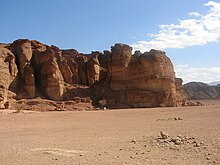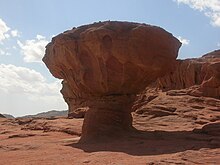User:Jensen4/Timna Valley Park

Timna Valley Park is a national park in the Negev desert of Israel and home to the world's oldest copper mines. It is located in the southwestern Arabah, approximately 25km north of Eilat, at the southern tip of Israel. The park is noted for its natural sandstone formations, including King Solomon’s Pillars, the “Mushroom,” and the “Arches." The copper mines are at least 6,000 years old and were worked almost continuously by the Egyptians, Midianites, Romans, Nabateans, and Umayyads, among others. Ancient mine shafts and rock carvings, a temple dedicated to the Egyptian goddess Hathor, and a replica of the biblical Tabernacle are some of the sites the national park offers to its visitors, in addition to its natural archaeological formations. Timna Lake, created by the Jewish National Fund within the park, provides many family activities for tourists, as well as shopping and dining. [1] The remains of the mines were discovered at the end of the 19th century, but scientific and public interest were minimal until the 1930’s, when American archaeologist Nelson Glueck theorized that the mines were connected to King Solomon. Excavations from 1959 to 1990 allowed archaeologists to reconstruct the history of the copper mines from 4,000 BCE to the Middle Ages.[2]
History
[edit]


Copper Mining
[edit]The Egyptians discovered copper ore as early as the 5th millennium BCE and began the world’s first copper production center in Timna valley. The remains the Egyptians and others left provided for the most extensive example of early mining of any kind in history. During the 14th century BCE, the Egyptians established a trade route through Timna Valley as the surrounding areas heard about the copper-rich area. At the same time the Midianites from the northwestern Arabian Peninsula began mining alongside the Egyptians. The Egyptian control of the mines declined in the 12th century BCE, but the Midianites stayed. The advanced Midianite culture left thousands of ceremonial artifacts and the Temple of Hathor, a treasured relic.[3] Mining continued by the Israelites and Nabateans through the Roman period and the first and second centuries CE, and then by the Ummayads from the Arabian Peninsula after the Arab conquest until the copper ore became scarce.[1] Timna Valley was also home to the beginning of the technological revolution, when people started using metal in daily life. Egyptians used metal chisels and hoes to mine and made tubular shafts with footholds in the walls to move down as far as 30 meters to reach the copper, all revolutionary methods for the time. [4]
Modern History
[edit]Archaeologists knew about the remains of copper production from surveys conducted at the end of the 19th century, but they were not given much attention. However, in the 1930’s American archaeologist Nelson Glueck claimed that King Solomon, who reigned in the 10th century BCE, was responsible for the mines, and Timna Valley became a center of scientific and religious inquiry, as well as public interest. Glueck named the site "King Solomons Mines," but the subsequent excavations performed by Professor Beno Rothenberg have not supported his theory.
In 1959 Professor Rothenberg, director of the Institute for Archeo-Metalurgical Studies at University College, London, led the Arabah Expedition, sponsored by the Haaretz Museum of Tel Aviv, the Institute of Archaeology, Tel Aviv University and, since 1974, the Institute for Archeo-Metalurgical Studies at University College, London. The expedition included a deep excavation of Timna Valley, and by 1990 he discovered everything that makes up the history of Timna Valley Park, including 10,000 copper mines and smelting camps with furnaces, rock drawings, geological features, shrines, temples, an Egyptian mining sanctuary, jewelry, and other artifacts never before found anywhere in the world.[3] His excavation and restoration of the area allowed for the reconstruction of Timna Valley’s long and complex history of copper production, from the Late Neolithic period to the Middle Ages.[2]
Timna Valley Park opened to share Rothenberg’s findings with the public, and there are around 20 different walking trails and some roads in the park to lead visitors to the various attractions. The Jewish National Fund, a non-profit organization that aids in the development of Israel, funded the creation of many of the non-historic tourist and family attractions and activities in the park.[3]
Archaeological Features
[edit]
Beyond the historical copper mines, Timna Valley attracts geologists and nature lovers with its rare stone formations and sand. Although predominantly red, the sand can be yellow, orange, grey, dark brown, or black. One can also find light green or blue sand near the copper mines. Water and wind erosion have created several unique formations that are only found in similar climates.[1]
Solomon's Pillars
[edit]
The most striking and well-known formation in Timna Valley is Solomon's Pillars. The pillars are natural structures that were formed by centuries of water erosion through a crack in the sandstone cliff until it became a series of distinct, pillar-shaped structures. [1]
They caused a surge of attention when American archaeologist Nelson Glueck claimed that the pillars were related to King Solomon in the 1930's and gave them the name "Solomon's Pillars." No information has proved this theory, and generally it is not accepted. However, the name stuck, and the claim gave the valley the attention that helped bring about the excavations and current national park.
The pillars are known to be the stunning backdrop for evening concerts and dance performances the park presents in the summer.[5]
Mushroom
[edit]
One of the roads available for visitors to drive through the park goes along the Mushroom, a unique rock formation that consists of a huge boulder on top of a small, red sandstone pillar. The authentic mushroom shape was caused by wind, humidity, and water erosion over centuries.[5] The Mushroom is surrounded by copper ore smelting sites from between the 14th and 12th centuries BCE.[1] The Mushroom is one of the reasons the roads were developed, because it is not in walking distance from the main park for everyone but remained a popular site.
Arches
[edit]The Arches were formed by erosion, as well, and can be seen along the western cliff of the valley. Arches are not as rare as Solomon's Pillars and the Mushroom, and similar structures can be found in elsewhere in the world. Arches National Park in Moab, Utah, in particular is famous for its arches. The walking trail that goes to the Arches also goes past the copper mine shafts.[1]
Man-Made History
[edit]
Shrine of Hathor
[edit]Professor Beno Rothenberg, the main excavator of Timna Valley, excavated a small Egyptian temple dedicated to Hathor, the Egyptian goddess of mining, at the base of the Solomon's Pillars. It was built during the reign of Pharaoh Seti I at the end of the 14th century BCE for the Egyptian miners. The shrine housed an open courtyard with a cella with an area cut into the rock to house a statue of Hathor. An earthquake caused the temple to be rebuilt during the reign of Pharaoh Ramses II in the 13th century BCE with a larger courtyard and more elaborate walls and floors. The dimensions of the original shrine were 15 meters by 15 meters, and it was faced with white sandstone that was found only at the mining site, several kilometers away. The hieroglyphics, sculptures, and jewelry found in the temple totaled several thousand artifacts, have provided a lot of important information for archaeologists.[4] A rock carving of Ramses III with Hathor resides at the top of steps next to the shrine.[1] When the Egyptians left the area in the middle of the 12th century BCE, the Midianites continued cultist activities in the temple. They erased the evidence of the Egyptian cult, effaced the images of Hathor and the Egyptian hieroglyphics, and built a row of stele and a bench of offerings on both sides of the entrance. They also turned the temple into a tented desert shrine and filled it with Midianite pottery and metal jewelry.
Rock Drawings
[edit]
There are many rock drawings throughout the valley that were contributed by different ruling empires over time. The Egyptians carved the most famous drawing, Chariots, consisting of Egyptians warriors holding axes and shields while driving ox-drawn chariots.[1] There is a road that leads visitors to the Chariots, located about 2 miles from the mines in a narrow valley.[5]
Archaeologists used the carvings to learn about the rituals and lifestyles of the various empires that once lived in the area. They also provide information about the plants and animals from the area, in addition to the life and work of the people. Gazelles and ibex still roam the area, but an image of these animals with ostriches found on a high ridge of sand suggests that ostriches once lived in the area, as well.
Replica of the Tabernacle
[edit]
A life-size replica of the biblical tabernacle, which is a portable tent the Bible says God instructed Moses to build in order to have a transportable sanctuary on the exodus from Egypt to the Holy Land, was constructed in recent years in Timna Valley Park. It does not use the original metals but is faithful to the biblical description in every other way. The replica includes the laver, which is a ceremonial basin, and altar in the outer court, complete with the menorah, incense altar and table of twelve loaves of bread for Shabbat. The only object inside the tabernacle, known as the Holy of Holies, is the ark containing the Ten Commandments, the rod of Aaron, and the pot of manna. [6]
Things to Do
[edit]In addition to the archaeological and historical sites, the park added recreation activities for families and tourists to enjoy while visiting Timna Valley. They offer tea in the Bedouin tents, overnight camping facilities, camel rides, an archery range, rappelling, a climbing wall, and a multitude of recreation and learning opportunities in Timna Lake’s surroundings.[3]
Mines of Time
[edit]The new Visitors' Center houses a 360-degree multimedia experience called Mines of Time that uses computer simulation and state-of-the-art animation to introduce visitors to the Egyptian and Midianite culture, history, and copper mining before they enter the rest of the park. It shares stories, riddles, and mysteries of Timna Valley for visitors to learn about the rich culture of the empires that once ruled the area. The presentation continues as visitors walk through an artificial mining system, complete with life-like miners and equipment.[3]
Timna Lake
[edit]The Jewish National Fund, with the help of a large donation by Avrum Chudeno of Milwaukee, Wisconsin, built the man-made Timna Lake and its surroundings as a center for family activities. A handicraft workshop offers kids a chance to make sand pictures, fill bottles with colored sand, press copper coin replicas, make pottery, paint, weave, and watch a demonstration of copper production. The lake also has a playground and offers paddleboat and bicycle rides, as well as an outdoor Bedouin restaurant by the lake and a souvenir shop. Nearby are hiking, rappelling, and rock climbing sites.[3]
